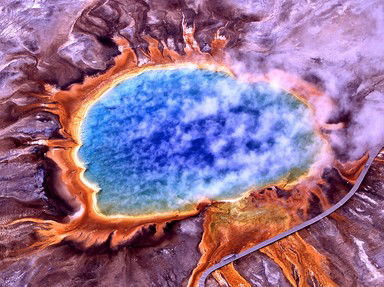Quiz Answer Key and Fun Facts
1. Our first photo shows the Grand Prismatic Spring, a structure approximately 370 feet (110 m) in diameter and 160 feet (50 m) deep. Its colours are caused by heat-loving bacteria. Is this structure on Earth or somewhere in space?
2. The next photo shows another circular structure, but this time it's not a spring. However, it is also moving and has been active for at least 350 years. Is it on Earth or in space?
3. This photo depicts a highly alkaline structure with a pH of up to 12. The high concentration of salt and minerals is caused by nearby volcanic activity. Earth or space?
4. Here we have a massive circular geological formation with a series of concentric rings. It is about 50 kilometres (30 miles) in diameter and is thought to be the result of either an ancient erosion process or an impact crater. Where is it?
5. The Bonneville Crater is a large circular structure with a diameter of about 7 kilometres (4.5 miles). It was formed by a massive impact event and lies on a rocky, desert-like surface. Earth or space?
6. This photo shows a massive swirling vortex called the North Polar Vortex. It looks like a hurricane, but it is not. Where can this phenomenon be found?
7. This formation is called "The Wave" - a striking geological structure with dramatic wave-like patterns of red and orange sandstone. These swirling stripes are the result of erosion. Where is The Wave?
8. This is the Nili Patera caldera - a bowl-shaped structure with intricate patterns of lava flows and volcanic deposits. Is it on Earth? Or in space?
9. Our next photo displays dark, smooth, lake-like structures scattered across a frozen surface. These bodies are filled with a liquid, but it's not water. Where do you think it is?
10. The last photo reveals a vast, mirror-like surface that stretches as far as the eye can see. This remarkable structure is made up of layers of salt. Where can you find this surface with a flatness so precise that it could be used to calibrate satellite instruments?
Source: Author
wellenbrecher
This quiz was reviewed by FunTrivia editor
looney_tunes before going online.
Any errors found in FunTrivia content are routinely corrected through our feedback system.
